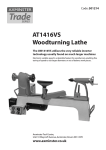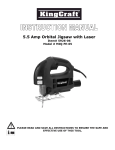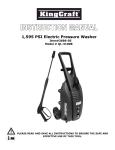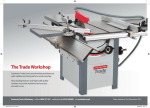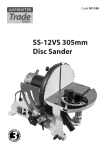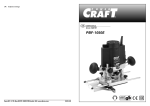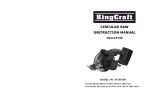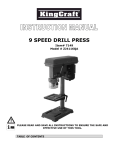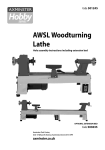Download Axminster AT1628VS Specifications
Transcript
Code: 502703 AT1628VS Variable Speed Wood Lathe Axminster Tool Centre, Unit 10 Weycroft Avenue, Axminster, Devon EX13 5PH www.axminster.co.uk Index of Contents Index of Contents 02 Declaration of Conformity 02 What’s Included 03 Optional Accessories 03 General Instructions for 230V Machines 04 Specific Safety Instructions for Woodturning Lathes 05 Specifications06 Assembly Instructions 6-10 Lathe Assembly 6-7 Lathe Stand Assembly 7-8 Lathe Extension Assembly 1 and 2 8-9 Illustration and Description 10-11 Operating Instructions 12-14 Rotating the Headstock 12 Removing the Faceplate 12 Indexing Facility 13 Removing the Drive Centre 13 Changing the Belt Speed 13-14 Maintenance14 Parts Breakdown/List 15-16-17-18-19-20-21 Wiring Diagram 22 Notes23 Declaration of Conformity manufactured byKingcraft Machinery Company Limited., is in compliance with the standards determined in the following Council Directive. Copied from CE Certificate The undersigned, authorised by Calvin Chon Manufactured by Kingcraft Machinery Company Limited/NO.26, Gong Yeh 12 Rd., Da-Li City, Taichung County, Taiwan., manufacturer, declares that the machine described hereafter: • EN ISO 12100-1: 2003 + A1: 2009 • EN ISO 12100-2: 2003 + A1: 2009 • EN ISO 1412-1: 2007 • EN 60204-1: 2006 + A1: 2009 • EN 61000-6-2: 2005 • EN 61000-6-4: 2007 WOOD TURNING LATHE Model Number: 1417-1430-1443-1643-1417INV-1430INV 1443INV-1643INV-1628INV-4224B-1642VS Please read the Instruction Manual prior to using your new machine; as well as the operating procedures for your new machine, there are numerous hints and tips to help you to use the Warning Fully read manual and safety instructions before use Ear protection should be worn machine safely and to maintain its efficiency and prolong its life. Keep this Instruction Manual readily accessible for any others who may also be required to use the machine. The symbols below advise that you follow the correct safety procedures when using this machine. Eye protection should be worn 2 Dust mask should be worn Two Man Assembly What’s Included Quantity Item Part 1 No Variable Speed Wood Lathe A 1 No Spanner B 1 No Push Rod C 1 No Spindle Lock Pin D 1 No Motor Plate Handle E 1 No Instruction Manual B Model Number 1628INV E C D Optional Accessories Quantity 1 No 4 No 1 No Item Lathe Extension 3/8” x 1 3/4” Hex Bolts & 8 No 3/8” Washers Tool Rest Extension Part Code Number H502704 2 No 8 No 4 No Lathe Stand 3/8" x 11/2" Bolts & 16 No 3/8" Washers Feet F502705 I G G F I H 3 General Instructions for 230V Machines It is good practice to leave the machine unplugged until work is about to commence, also make sure to unplug the machine when it is not in use, or unattended. Always disconnect by pulling on the plug body and not the cable. Once you are ready to commence work, remove all tools used in the setting operations and place safely out of the way. Re-connect the machine. Good Working Practices/Safety The following suggestions will enable you to observe good working practices, keep yourself and fellow workers safe and maintain your tools and equipment in good working order. WARNING!! KEEP TOOLS AND EQUIPMENT OUT OF THE REACH OF YOUNG CHILDREN Carry out a final “tightness” check e.g. chuck or face plate, workpiece, tool rest, etc., check that the correct speed has been selected. Primary Precautions Make sure you are comfortable before you start work, balanced, not reaching etc. If the work you are carrying out is liable to generate flying grit, dust or chips, wear the appropriate safety clothing, goggles, gloves, masks etc. If the work operation appears to be excessively noisy, wear ear-defenders. If you wear your hair in a long style, wearing a cap, safety helmet, hairnet, even a sweatband, will minimise the possibility of your hair being caught up in the rotating parts of the tool, likewise, consideration should be given to the removal of rings and wristwatches, if these are liable to be a ‘snag’ hazard. Consideration should also be given to non-slip footwear, etc. These machines are supplied with a moulded 13 Amp. Plug and 3 core power cable. Before using the machine inspect the cable and the plug to make sure that neither are damaged. If any damage is visible, have the tool inspected/repaired by a suitably qualified person. If it is necessary to replace the plug, it is preferable to use an ‘unbreakable’ type that will resist damage. Only use a 13 Amp plug, and make sure the cable clamp is tightened securely. Fuse as required. If extension leads are to be used, carry out the same safety checks on them, and ensure that they are correctly rated to safely supply the current that is required for your machine. Work Place/Environment DO NOT work with cutting tools of any description if you are tired, your attention is wandering or you are being subjected to distraction. A deep cut, a lost fingertip or worse; is not worth it! Above all, OBSERVE…. make sure you know what is happening around you, and USE YOUR COMMON SENSE. Make sure when the machine is placed that it sits firmly on the bench or stand, that it does not rock, that it is sufficiently clear of adjacent obstacles so that you have unimpeded access to all parts of the machine. The machine is designed for indoor use, do not use when or where it is liable to get wet. Keep the machine clean; it will enable you to more easily see any damage that may have occurred. Clean the overall machine with a damp soapy cloth if needs be, do not use any solvents or cleaners, as these may cause damage to any plastic parts or to the electrical components. Clean the machine components with a lightly oiled cloth. If the machine is liable to be standing idle for any length of time a light coat of machine or spray oil will minimise rusting. Keep the work area as uncluttered as is practical, this includes personnel as well as material. Under no circumstances should CHILDREN be allowed in work areas. 4 Specific Safety Instructions for Woodturning Lathes 1. Do not use ‘split’ work pieces. faceplates etc.,) can be ‘locked’ onto the lathe mandrel, and in the case of chucks have some form of security device to prevent them ‘unwinding’ during reverse operation. 2. Always start at the lowest speed when starting a new task. 8. Make sure your tools are stored/racked away from the turning area of the lathe. Do not reach over a rotating workpiece at any time. 3. Check that the tool rest is at or slightly below the centre line of the workpiece. 4. Check the workpiece is securely mounted in the lathe before switching on the power. 9. Do not ‘dig in’ or try to take too large a cut. 10. Do not leave the lathe running unattended; or leave the machine until everything is stopped. 5. Rotate the workpiece by hand, to check that it is centralised, clear of the tool rest, not ‘split’ or has loose knots. 11. Some turning tools may have specific sharpening angles that have been determined by the manufacturers; when re-sharpening, adhere to these angles to maximise the finish of your work. 6. Where lathes have the facility to be reversed; check the machine is rotating in the correct direction. 7. If your lathe has the facility to run in reverse, you must ensure that the mounting accessories (chucks, Specification Code502703 ModelAT1628VS Rating Trade Power 230V 50Hz 1.5kW Speed Low 0-1,600rpm High 300-3,750rpm Spindle Taper MT2 Spindle Thread M33x3.5mm (Ref T38) Taper Tailstock MT2 Distance Between Centres 700mm Max Diameter Over Bed 203mm Overall L x W x H 1115 x 450 x 460mm Weight96kg 5 Assembly Instructions Please take some time to read the section entitled “Illustration and Description” to identify the various parts of your machine so that you are familiar with the terminology we will use to enable you to set up and operate your table lathe safely and correctly. be cleaned from the lathe, its components and accessories prior to it being set up. Use degreaser to remove the barrier grease. Be warned, it will stain if you splash it on clothing etc., wear overalls, rubber gloves are also a good idea, as is eye protection. After cleaning, lightly coat the machine with a thin layer of light wax. If you used paraffin/kerosene make sure you apply this thin film sooner rather than later. The lathe and its accessories will arrive coated with corrosion preventative grease. This will need to WARNING: The wood lathe is a heavy machine, it is advisable to use a lifting device such as a hoist, scissor lift or seek help when assembling the lathe. Unpack your new 1628 Variable Speed Lathe and recycle the packaging responsibly. The cardboard packaging is biodegradable. Lathe Assembly (Code: 502703) The majority of the machine comes fully assembled, the remaining items to be assembled is described below. Locate the motor plate handle (E) and screw it into the pre-drilled hole in the motor tension bracket, see figure 1 Figure 02 Figure 01 Headstock stop bracket E a Figure 03 We recommend you remove the headstock, tool rest and tailstock from the lathe bed before lifting the lathe assembly off the pallet as the lathe is very heavy. 1. Loosen the headstock stop bracket (a), to the left side of the lathe bed and with help slide the headstock off the lathe bed and place safely aside, see figures 2-3. 2. Remove the tailstock stop bolt (b) from the right hand side of the lathe bed and remove both the tailstock and tool rest assembly and place safely aside. (See figures 4-5-6) Remove the headstock from the lathe bed 6 Assembly Instructions Figure 04 Figure 07 b Figure 05 Figure 08 A Figure 06 Figure 09 F 3. Lift the lathe bed from the pallet onto a work bench, see figs 7 then refit the headstock, tool rest and tailstock as described in steps 1 and 2, see figure 8 G Lathe Stand Assembly (Code: 502705) 1). Locate the two lathe stands (F) and the four feet (G).Screw the threaded feet into the pre-drilled holes to the base of the stands. (See figure 9) 7 Continues Over... Assembly Instructions Figure 13 Remove the headstock, tool rest assembly and tailstock from the lathe bed as before to make it easier to assemble the stands 2. After removing the above lift the lathe bed using a scissor lift, lifting host or seeking help. 3. Place the stands (F) to each end of the lathe bed and line up the holes in the stands with threaded holes in the lathe bed, secure using the 3/8" bolts and washer (c),see figures 10-11-12-13. 4. Replace the headstock, tool rest and tailstock. (See figure 14) Use a lifting device as a scissor lift for example to raise the lathe bed to mount the lathe stands Figure 10 Figure 14 F G Figure 11 c Adjust the feet (G) until the lathe is level Lathe Extension Assembly (Code: 502704) The lathe extension (H) bolts onto either end of the lathe bed which increases the length of the lathe for turning larger projects. The lathe extension can also be mounted to the stands for turning large diameter projects. Figure 12 Assembly 1 1. Locate the lathe extension (H) and 3/8" Hex bolts and washers (d). Remove the tailstock stop pin from the end of the lathe, see figure 15 and place safely aside. 2. Line up the centre hole in the lathe extension (H) with the lathe bed centre pin, see figure 16, push on the lathe extension so it’s flush against the lathe bed, line up the holes and secure using the 3/8” Hex bolts and washers (d). (See figure 17) c 8 Assembly Instructions Figure 15 Assembly 2 1. Line up the holes in the lathe extension (H) with the threaded holes in lathe stand (F) and secure using the 3/8” Hex bolts and washers (d), see figure 18. Figure 18 H Remove the tailstock stop “PIN” and place safely aside Figure 16 d Using the 3/8” Hex bolts and washers (d), secure the lathe extension in position 2. Release the headstock lock and slide the headstock down to the end of the lathe bed and lock in position. Slide the tool rest assembly onto the lathe extension (H), undo the tool rest locking handle and remove tool rest. Locate the tool rest extension (I), slot the tool rest extension into the machined recess and tighten the clamping handle. Slot the centre pin into the centre hole in the lathe extension (H) 3. Loosen the clamping handles on the tool rest extension (I) and slot the tool rest into the extension, tighten the tool rest locking handle. (See figure 19) Figure 17 Figure 19 H Tool rest Tool rest lock I Holding the lathe extension, secure in place using the 3/8” Hex bolts and washers (d) Tool rest assembly d 9 H Illustration and Description Motor locking handle Headstock Tailstock Faceplate Live centre Tool rest Banjo lock Tool rest lock Headstock pivot lock Headstock locking handle Control box Spindle speed LED Tailstock wheel Access panel Tailstock barrel lock Lathe bed Tailstock lock stop Tailstock lock Banjo 10 Motor plate handle Illustration and Description ON OFF The control box has a magnetic base enabling it to be positioned anywhere on the lathe ON (Green) and OFF (Red) buttons Forward and Reverse switch The Speed Control Knob, enables you to increase or decrease the speed of the spindle Indexing ring Index lock pin Headstock Pivot Lock, pull this knob to rotate the headstock to the desired position Indexing ring facility and locking pin is used for fluted columns, clock faces and accurate hole positioning 11 Operating Instructions Figure 20 Rotating the Headstock The Headstock can be swivelled in any position by lifting up the Headstock locking handle (a) and pulling the Headstock pivot lock (b) out, swivel the Headstock to the desired position is reached, lock in place by pushing down the headstock locking handle (a). (See figure 18) The Headstock incorporates two index positions 45˚and 90˚, swivel the headstock until it locks in place to allow bowls to be turned in front of the lathe. (See figures 19-20) Figure 18 The Headstock locked in the 90˚ index position Removing the faceplate Locate the spindle lock pin (D) and the spanner (B), inset the locking pin (D) into the pre-drilled hole in the headstock and using a Hex key loosen the grub screw on the spindle, see figure 21. Using the spanner (B) remove the faceplate, see figure 22. a Figure 21 b Faceplate Lift up the Headstock locking handle (a), pull the Headstock pivot lock (b) out and swivel the Headstock to the desired position Figure 19 Hex key D Figure 22 B The Headstock locked in the 45˚ index position 12 Operating Instructions Figure 25 Indexing facility DISCONNECT THE LATHE FROM THE MAINS SUPPLY Drive centre The Indexing ring is situated to the left side of the headstock which incorporates 36 positions at (10˚) segments. To the side of index ring is the index locking pin to lock the spindle in position. The indexing facility is useful for fluted columns, clock faces and accurate hole positioning. (See figure 23) C Figure 23 Index ring Repeat the procedure for the live centre in the tailstock. Index marker 10˚ Segments Changing the belt speed Note: The lowest speed pulley combination is furthest from the faceplate, the smallest motor pulley diameter to largest spindle pulley diameter. Index lock pin DISCONNECT THE LATHE FROM THE MAINS SUPPLY BEFORE CHANGING THE BELT Line up the measurement you require on the index ring with the index marker on the headstock and screw in the index locking pin to lock the spindle in position. (See figure 24) Open up the pulley access panel on top of the headstock by removing the Hex screw. Slacken the belt by loosening the motor locking handle (a), move the motor until the belt is slack enough to be reposition. (See figure 26) NOTE: Make sure the measurement is in line with the index marker otherwise the locking pin may not in gauge properly. Figure 24 Figure 26 a Removing the Drive Centre To remove the drive centre from the spindle, locate the push rod (C), insert it through the index ring assembly and push the drive centre out, see figure 25. 13 Loosen the motor locking handle (a) enough to allow the pulley to be repositioned Continues Over... Operating Instructions Figure 27 Reposition the belt, making sure the groves in the belt slot into the groves in the pulleys. Pull/push the motor assembly until the belt is under tension, retighten the motor locking handle (a). (See figure 27) Close the pulley access panel and replace the Hex screw. Maintenance The woodturning lathe has little maintenance, but it is advised to do the following checks to keep the lathe in good working order. Monthly check • Check the tension of the belt and adjust, see previous page for changing the belt speed. After every use • Clean wood shavings away from the lathe bed and tool rest • Check any build up of wood shaving on the motor and spindle pulley’s and clean if necessarily. • Using a airline, blow out the motor’s air vents. • Smear a light coat of wax (Protec Tool Wax Polish, Code. 211835) over the lathe bed to allow the Banjo and Tailstock to run smoothly over the lathe bed and to prevent corrosion. NOTE: Always use a dust mask and eye protection NOTE: If the lathe not going to be used for a period of time, smear a light coat of wax over the lathe bed and place a dust sheet over the lathe. Wax Points 14 Parts Breakdown/List Headstock Assembly A 15 Parts Breakdown/List Headstock Assembly A 16 Parts Breakdown/List Headstock Assembly A 17 Parts Breakdown/List Body Assembly B 18 Parts Breakdown/List Body Assembly B 19 Parts Breakdown/List Stand Assembly C (Optional) 20 Parts Breakdown/List 21 Wiring Diagram 22 Notes 23 Please dispose of packaging for the product in a responsible manner. It is suitable for recycling. Help to protect the environment, take the packaging to the local recycling centre and place into the appropriate recycling bin. Only for EU countries Do not dispose of electric tools together with household waste material. In observance of European Directive 2002/96/EC on waste electrical and electronic equipment and its implementation in accordance with national law, electric tools that have reached the end of their life must be collected separately and returned to an environmentally compatible recycling facility.
























